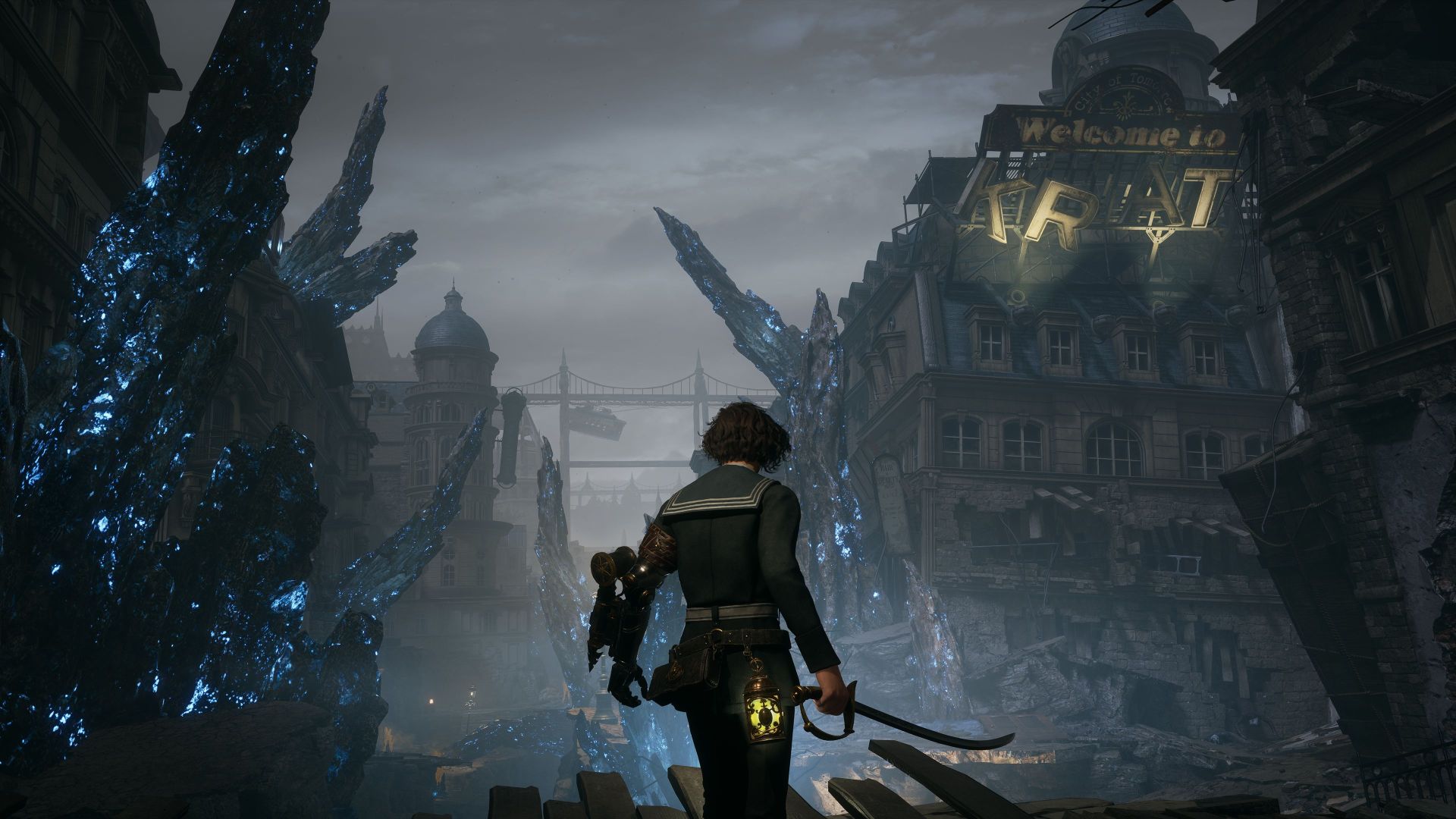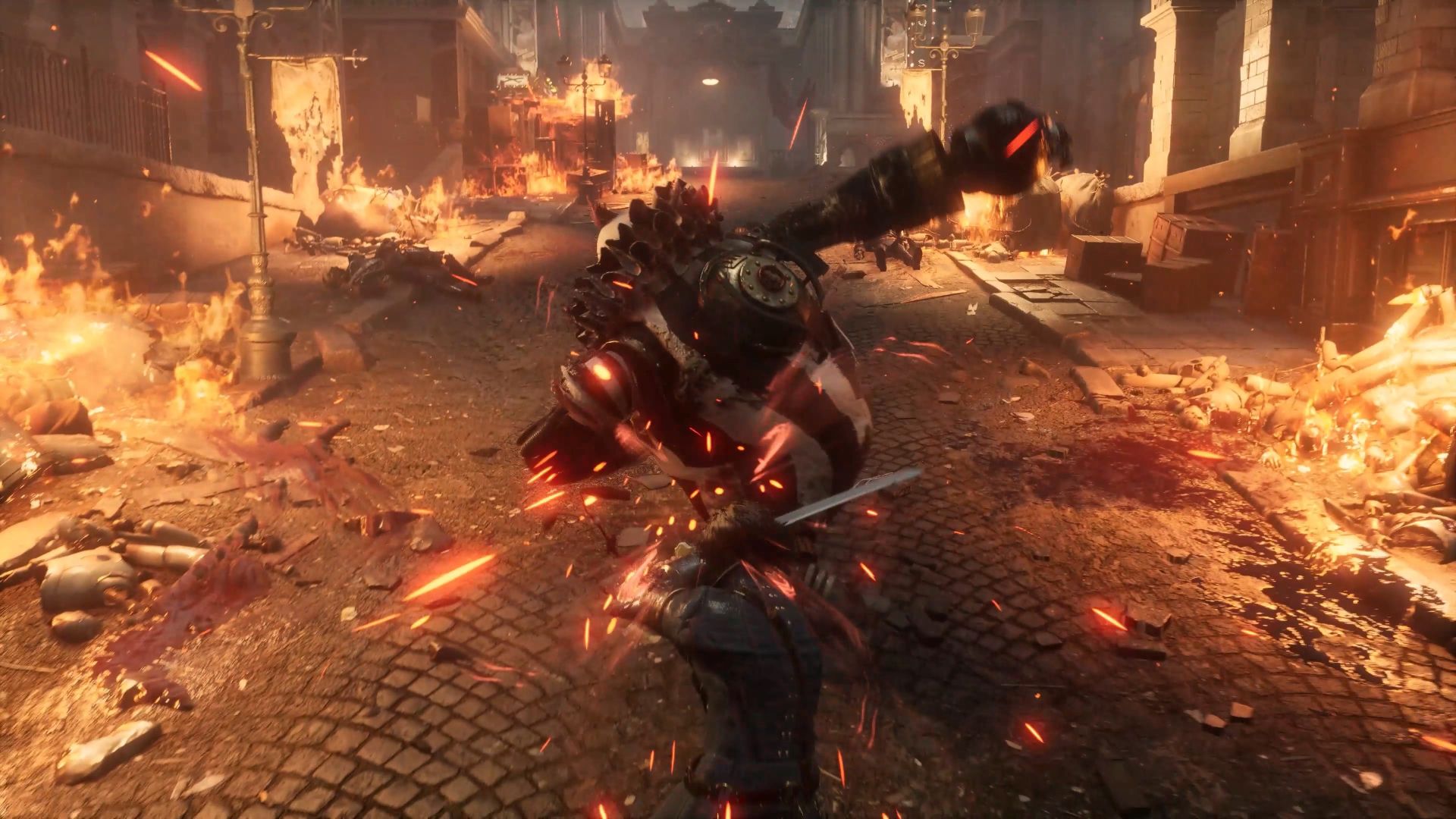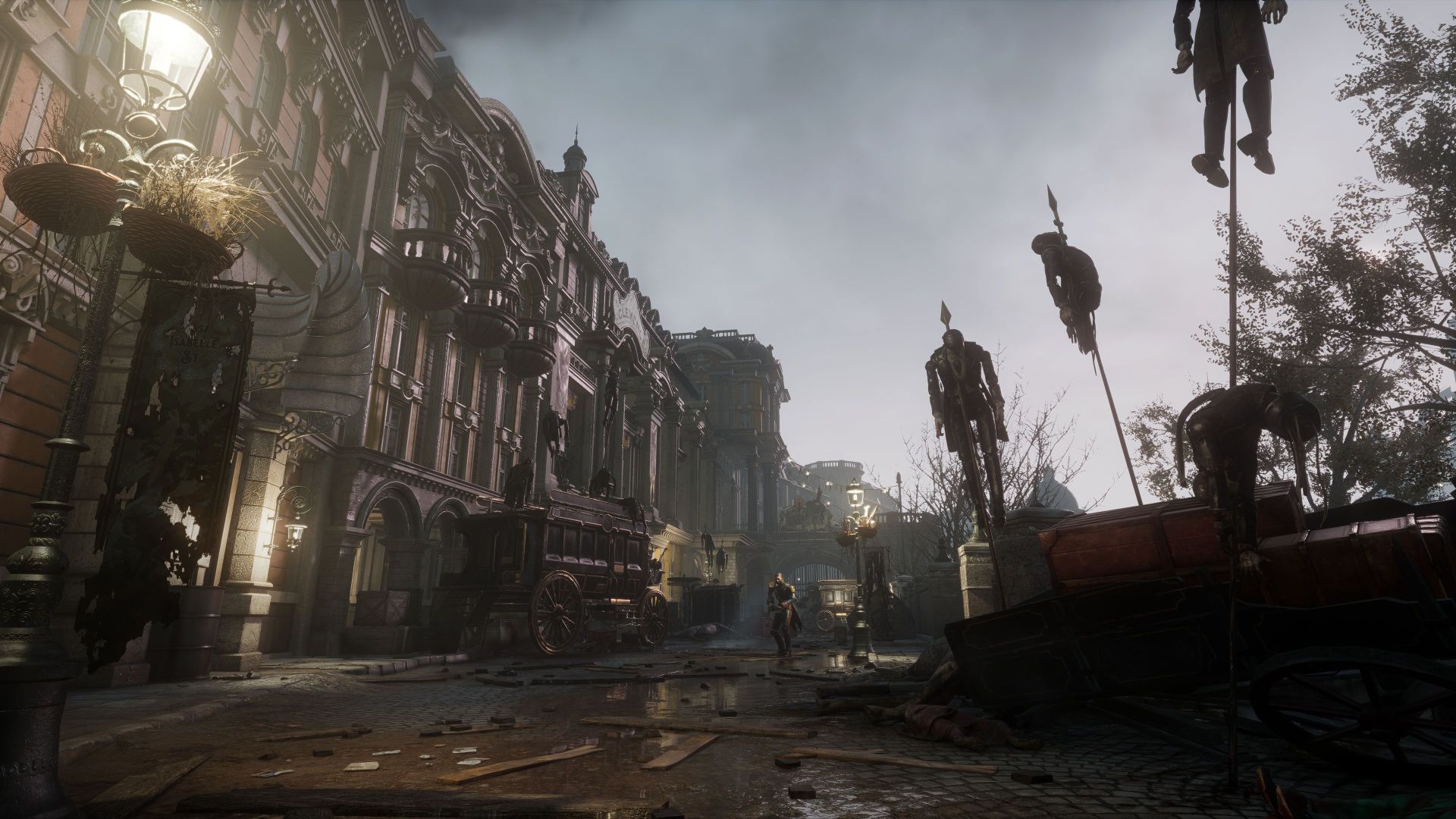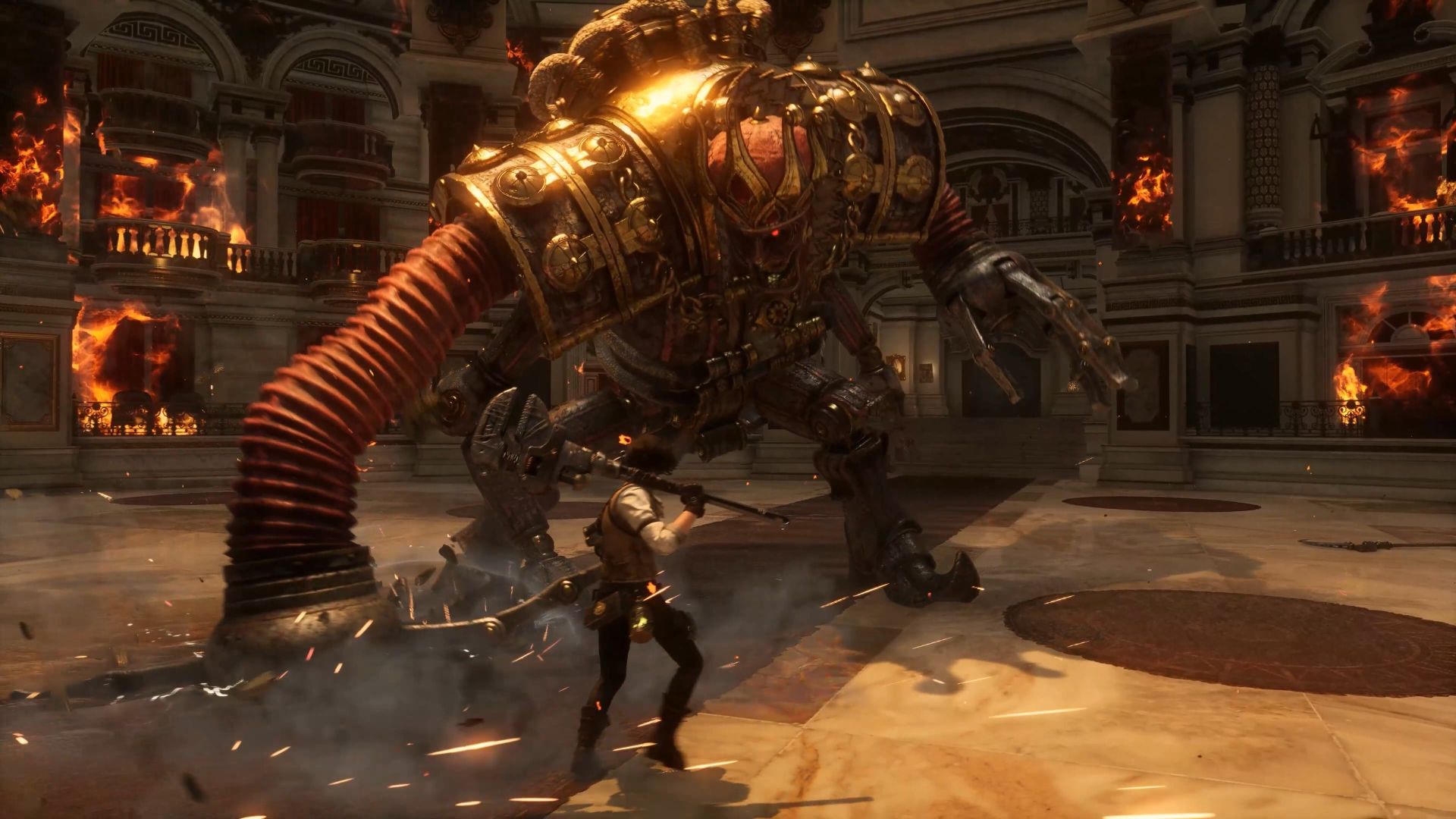South Korean developer Neowiz leaps into the Soulslike genre with a powerhouse release this month, and that’s no lie. Lies of P is a dark take on the classic Pinocchio story that has players controlling Pinocchio in an effort to save the last bastion of humans in a fictional European city of Krat during an alternate late 1800s period. This once small, poor, coastal town grew to prominence when alchemists used the power of a mysterious material called Ergo to lead the town into an industrial age. This same material is what powers the puppets, designed by Geppetto, to serve humans. Alas, something has turned the puppets against their creators in a most violent way. Making things even worse is the petrification disease that turns organic beings into puppets. What is behind this madness is an unknown that your tasked with finding out and ultimately stopping.

Lies of P is played from a traditional third person perspective with a focus on action-heavy RPG gameplay. It’s a Soulslike, meaning it’s intentionally very challenging and emphasizes — and typically flat out requires — precision offensive and defensive skill to survive. You’re going to die a lot in this game, so get used to it. If you know the genre, you know this is just par for the course. I still consider myself a rookie with Soulslike, and recognize these games take a particular kind of patience and perseverance to get through. In return, you can expect often outstanding stories, characters, atmosphere, and a generally very rewarding experience, even if you never want to revisit it again when it’s over. What I keep in mind on these games is that if I can just survive and inch forward for about seven hours, the frustration of dying and the repetition ends up being worth it, and the tide slowly turns. I never felt overpowered in Lies of P, but you do certainly get to that point when former enemies just are no longer intimidating or threatening anymore, and that’s a good feeling. Anyway, with Lies of P, the first several hours were a mixture of captivating fun and brutally difficult boss fights that had me going through the seven stages, let me tell you. At times I questioned why I even play videogames, how will I ever get past this boss, etc — it’s hilarious looking back just minutes after advancing, but when you’re on your fortieth-plus try against a boss, it’s all pretty crushing. And Lies of P maintains an intimidating difficulty throughout, but somewhere around that seven or eight hour mark, unveiled gameplay elements, character leveling, my inventory, and yes, even my skills merged to where I was still getting my butt kicked at times, but not as hard and not for nearly as long.

Let’s get more specific now. The adventure begins with players being able to choose between three starting character types, or combat styles, that set your base levels of different attributes that define your character’s strengths and weaknesses the rest of the way. Vitality, Vigor, Capacity, Motivity, Technique, and Advance are the main categories, with these having an effect on character HP, Stamina, Guard Regain, Weight Limit, Physical Attack and Physical Defense. In the most basic way to summarize it, you can go for tank, speed-and-precision, or a balance, which is what I ultimately went with. Expect to encounter plenty of interesting enemies that run the spectrum of small, dagger-like types to massive, screen-filling monsters that have incredible power and reach. Neowiz does a great job of keeping the player on their toes, meaning for each new area, you just never knew what kind of enemy you’re going to face. They might be small and quick, or large tank-likes with jagged timing to their attacks. This keeps you vigilant when it comes to spending your Ergo on consumables, weapons, weapon upgrades, and leveling up. I focused a lot on Vitality and Vigor, as well as Technique, but fifteen hours or so in I had to start pouring more into Capacity to be able to utilize some of the legendary weapons and Amulets that weighed a ton.
Speaking of weapons, Lies of P offers lot of weapon types and means to customize and upgrade them. Each weapon is considered to have two parts — the Blade and the Handle, even if the blade per se is a blunt force instrument rather than having a sharp edge. You can mix and match blades and handles pretty early on in the game with the help of a NPC character at the game’s main hub, Hotel Krat. The weapons master lady here can upgrade your Blade as well as the Handle if you have the right items and just a little bit of Ergo to spend. Blade upgrades are done with various Moonstones found throughout the game world, while handle upgrades require different crank pieces which are most easily purchased through another NPC character. Upgrading your Blade is fun and rewarding, with really no penalty at all. Upgrading your Handle on the other hand will increase, say, its Attack stats some, but diminish the Technique stat. Upgrading and mixing up the weapons is ok, but at times I felt like I was splitting hairs in the differences between them. There are a lot of stats numbers to look over, but the key differences are highlighted in colors to help you quickly understand what’s changing. Anyway, I only bothered to disassemble and reassemble weapons a few times, and stopped adjusting Handles after two or three iterations, but I always kept a sharp eye out for the Moonstones for the Blade upgrades.

In battle, players can quickly switch between two weapons by pressing right on the d-pad. In my usage, for the most part, I went with a Greatsword class alongside the first sword you get in the opening moments of the game (upgrading both as often as I could). Certainly, several other weapons along the way proved useful, from the massive bonesaw to a rapier’s sword, to the massive blunt force wrench, but for me, I did my best when combining a light and heavy sword. Each weapon uses different amounts of Stamina (the green gauge in the HUD) for its attacks, and also for blocking, which is a critical element to the gameplay. You can block early, and sustain damage, but that damage can be regained if you quickly follow-up on your attacker with successful attacks. You also have Perfect Guards, whereby your timing is indeed perfect, and you take no damage and the enemy can be countered. Do enough damage to an enemy and their weapon might fail, though I only saw that a few times when I teleported back to early game levels to revisit a merchant or find a secret area that I had been given a key to. On the offensive end, if you damage an enemy enough in a short enough amount of time, they will enter a vulnerable state (indicated by a white box surrounding their HP meter) whereby you can hold R2 and land a Staggering attack that really gives you a chance to lay into them. Sounds great, but in my experience, I often times was out of Stamina by the time I got the enemy to a Staggerable state, or, I missed the hit because some lesser enemy or the one I was trying to hit sneaks in a hit before I could hold R2 long enough. You can upgrade the window for landing a Stagger hit with the most preciously resource in the game, Quartz, and I would recommend doing so.
Weapons degrade with usage, but one of your super handy Base items is a grinder that you can equip onto a Belt, more on the Belts in a second. Weapons can also be temporarily imbued with extra punch, like fire, acid, or electric shock abilities, by using the Grinder to give them this extra edge, so to speak. Weapons also each have what are known as Fable Arts — these are the blue meters under the Stamina meter in the HUD. Each weapon has a special move, performed with Triangle. If you press L1+Triangle, you can activate the Handle’s Fable Art, which might give you something like an increased chance at a critical hit or some other passive ability, while the regular Triangle press will launch a powerful Blade-based attack. Fable Arts can be refilled with Consumables, or simply by fighting enemies, and they offer a critically important extra angle of attack that I upgraded and used more and more throughout the game.

In addition to the bladed weapons, P’s left arm, you’ll notice, is pretty wicked looking and is a weapon itself. It even has its own upgrade tree and options. The Legion Arm, as its known, is an immensely useful tool that can be swapped out and upgraded for a variety of mostly-offensive effects as you go through the story. I found the flame-emitting Arm to be the most useful and satisfying, but the Falcon Eyes (which gives you ranged shooting), a special shield Arm, and the other cool options are all enticing and useful, too. When it comes to offensive gadgets, Neowiz did a great job — and you’re going to need to put everyone of them to use to succeed.
P also dons a both an Upper and Lower belt, each with three item slots. You also have an Extra Bag that is accessed by holding X, which brings up four options (d-pad buttons). For most Consumables, the game by default only lets you carry three to keep you from being able to spam the bad guys. On several occasions, I would load my Belts with various offensive consumables — Thermite, Acid-filled canisters, shot put balls, sawtooth blades, sharp pipes — whatever it was to help me take a tough enemy’s HP down — and then lock-on (R3) and chuck as many of these as I could at them. You access the Belts with Up and Down on the d-pad, and then pressing Square on whatever item is selected. In the heat of battle, I messed this up a few times in various ways (accidentally consuming a precious healing vial when I meant to use another Belt item, for example), but in general it works really well, especially seeing as there is no pause function to the game.

Lies of P is obviously very combat focused, and Neowiz has outfitted players with a lot of options and layers when it comes to their weapons, consumables, and the Legion Arms. When it comes to defense, which is at least as important as offense, you have the ability to block, dodge, run, find and equip various defensive items (not armor, but puppet parts, basically), healing vials, effect resistance power-ups, and you can level up resistance stats, too. Also, don’t underestimate the power of running right the heck past enemies that you have already defeated (that respawned whenever you activated a save point, known as a Stargazer). In a couple of situations during the course of the game, I also leveraged the ‘invisible walls’ of bigger enemies’ patrol areas, I guess you could call them. In the back third of the game, I at times got pretty clever about cheesing through a couple of the ‘mid-level boss’ types (the really heavy enemies that don’t respawn and have unique items) by getting them stuck or going in and out of their zone — and after the hell that I went through on some earlier (and even latter) boss fights, I didn’t feel bad about it, either.
End-level bosses are a huge part of the game, so I’d like to spend a moment talking about them, without spoilers. If you played the demo that Neowiz put out in June, you have already seen a couple of these, but suffice to say they’re all unique, challenging, and entertaining. You will know you’re about to step into the boss area by a little pedestal of what looks like water outside of an ominous door. I really liked Neowiz’s idea of being able to use a Consumable item, known as a Star Fragment, at these pools to call in a nameless/faceless NPC specter to fight alongside you. It makes an incredible difference in most cases and I leaned on these heavily if I could not defeat a boss on my own accord after a dozen or twenty tries. The Specters’ HP and brains aren’t the best, but they will at least give you some free hits on the boss while the boss is attacking them. Their offense attacks combined with yours can help get a boss to the point of Stagger, which can greatly change the outcome. For players on limited time with limited skills, having this option to get a little bit of extra help from a NPC was really appreciated.

I also liked how, when you die at a boss, your Ergo is placed safely just outside the boss door. Plus, a Stargazer (check/savepoint) is located very near the boss encounter (maybe 30s away at most, running). So, you can avoid all of the respawns and get back to your bossfight to reclaim the Ergo untouched, which is nice. I should mention, your Death Ergo as its called will diminish greatly in value if you take any damage or die along the way of trying to get it back. That it doesn’t completely disappear after a certain amount of time or if you accidentally die on the way to picking it back up is great, though. In fact, Neowiz does several player-friendly services like this, such as giving you the ability to teleport back to your last Stargazer, or Hotel Krat (home base) instantly at anytime with the use of a Base item that resembles a pocket watch. This bailed me out of headaches on more than one occasion. Even though all normal enemies respawn every time you travel, being able to instantly teleport to safety is well worth it.
I also appreciated that certain merchants and enemies are placed near certain Stargazers that make grinding for items like Star Fragments or Consumables about as efficient as possible, all things considered. Another great player-convenience was auto sending stuff to Storage when you purchase or collect too many of a storable item, as well as how your inventory refills from your Storage automatically when you access Storage (which is done at Stargazers). I also liked, but didn’t realize until several hours in, that you can fill-up your Fable Arts meters instantly at the Hotel simply by stepping out into the practice courtyard, which is conveniently positioned next to the weapons vendor. Here, you can try your new weapon builds and such out on two dummies — one that hits back and the other that doesn’t.

Two other things about player convenience and efficiency I noticed and appreciated is how each stage within a level has a door, elevator, or ladder that allows you to skip much of the stage so that when you comeback to it you don’t necessarily have to fight through a bunch of respawns again. Oh, and regardless of where you are teleporting to and from, expect load times to be pretty snappy at well under twenty seconds on PS5.
I enjoyed the fluidity and loop of Lies of P in as far as routinely circling back to Hotel Krat to buy and sell goods, level up in multiple ways (character stats, passive abilities, Legion Arms, Weapons), and partaking in some interesting side events that are offered at the Hotel and around Krat in general. The coolest of these is finding the Trinity rooms, and the key for them. I’m trying to be intentional vague so as to not drop spoilers, as I thought this was one of the coolest ‘game within the game’ things I had ever experienced in a Soulslike. You will have opportunity to utilize other neat gameplay ideas like Gestures, Records to play on the gramophone, and locate and pet the Hotel cat, too, all of which subtly alter P’s humanity. I thought these little extras were a neat addition to the otherwise dark, semi-horrifying, combat-heavy game.
Overall, there’s certainly a lot more to like or love about Lies of P than to not. I did jot down a few gripes along the way, such as the lack of music in most stages. In fact, the sound of P’s footsteps make up a lot of the soundscape in the early hours, but this gets better as you go along and the atmosphere of the levels just lend themselves to a more dynamic soundscape. The atmosphere and tone of the levels is pretty great, although I found the first main level and its stages a little bit blah in terms of design, yet the rest of the game level design is great. While the general direction is pretty linear, of course, there are enough little side paths and things to explore that you’ll want to be really thorough and you’re rewarded for doing so with pick-ups and the potential to stumble across some cool rare item (like a Record, a document, or other cool don’t-want-to-spoil-for-you stuff) — or well, non-items too, shall we say.

Expect tons of wooden crates, boxes, and barrels placed all around Krat, for some reason, many of which you can break and many of which will just ding your weapon’s durability. I don’t totally get the reasoning games always include tons and tons of breakable wooden storage containers that are placed in the most nonsensical places at times, but, they’re here. Rarely, you will find a pick-up or a brief alternate pathway hidden behind (not in) these containers, but for the most part it just feels unnecessary to have so many breakable containers scattered about; granted, this is very minor gripe.
Probably the biggest gripe I had was how some enemies could clip through walls or ceilings with their attacks, and other times they couldn’t. This was hard to put a finger on, but I observed enemies attacking through walls, doors, and even leaping partially into ceilings at times, as well as clipping right through other enemies, but please note this was pretty rare and by far the majority of the combat was polished and “believable.” I did have, on at least a half dozen occasions though, times where either I got trapped in a corner or against a wall and between the camera and the chaos I was dead in seconds with no ability to see my character or tell what the heck was going on. This happened unintentionally while moving back away from foes mixed with their rapid advancing. Wasn’t fun when it happened, and I’m not sure if there’s really a fix for this other than making sure you don’t avoid getting cornered or backed into a wall. On the other hand, one readily fixable glitch I encountered was the floor in one level would give me Decay damage even though the substance causing the Decay was no longer there — I’m tip-toeing around spoilers here, but this was clearly a glitch that would be easily patched out.

On the PS5, Lies of P looked and played great. I never had a hint of framerate trouble, and other than the aforementioned enemy clipping things were stable and reliable. I experienced exactly zero crashes and load times are consistently fast throughout. The menus and icons and such were clean and easy to understand and navigate as well. I talked about the sound package some earlier, and while it left room to improve, it’s pretty good as is, especially the audio cues and effects during the heat of battle that add a lot of thrill to the experience.
For Neowiz’s first big AAA-caliber game, they have done a bang-up job with Lies of P. The story, characters, combat and RPG systems, controls, enemy design, level design — there’s a lot here that is done with excellence and the summation of these is a great game that I’d happily recommend to anyone that enjoys the tough-but-rewarding Soulslike genre.
###





